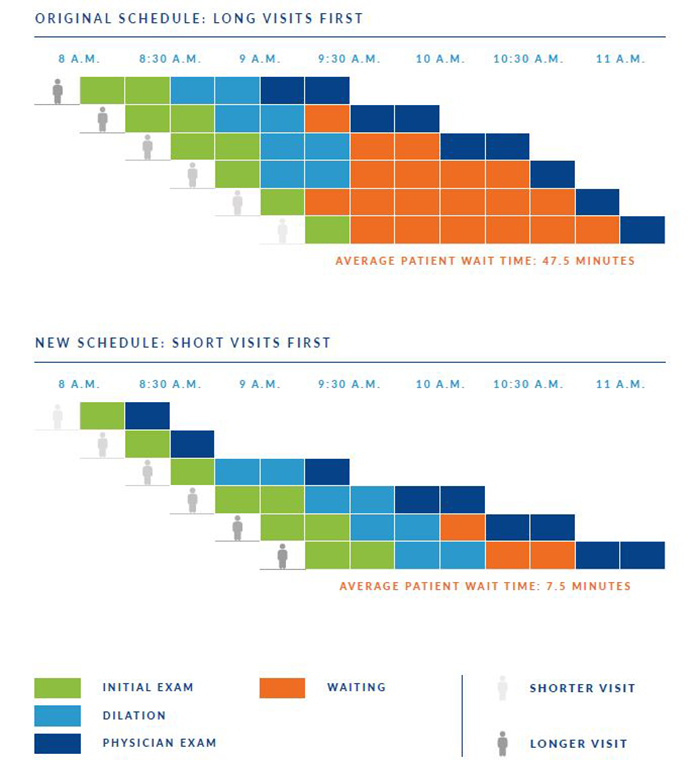
the original schedule, patients with longer visits (darker icon) were often scheduled in the first appointments of
the clinic so they wouldn’t extend the length of the clinic. This resulted in more wait times than when patients
with shorter visits (lighter icon) were scheduled first in our new schedules.
Innovations: Data-Driven Medicine 2021
OHSU Casey Eye Institute is a pioneer in the use of computers to support patient care. We were among the earliest adopters of electronic health record systems (EHRs) in the country. Utilizing data from these systems, OHSU Casey Eye Institute informaticists created novel computer models designed to maximize clinic productivity without reducing patient satisfaction. Using new scheduling templates based on these models, average wait times in pediatric eye clinics reduced by 15 percent while clinic volumes increased by 15 percent.
“OHSU Casey Eye Institute is unique in having a dedicated informatics group that works closely with clinicians,” said Michelle R. Hribar, Ph.D., a clinical informaticist working in Ophthalmology. “In doing this project, members of the informatics group spent hours in clinic observing and timing the workflow, getting to know the clinicians and talking with the scheduling staff. Our result is a model we believe other clinics can take and apply their data to with similar outcomes. Our next goal is to expand this model to other subspecialties in ophthalmology, such as glaucoma.”
OHSU Casey Eye Institute was one of the first institutions to use EHR audit log data for modeling clinic workflow. EHR systems are required to record audit logs that track users’ actions in the EHR, including timestamps. Hribar mined millions of timestamps from audit logs for the simulation models of clinic days at OHSU Casey Eye Institute. After thousands of simulations, Hribar learned how to plan for patients more efficiently throughout the day.
“If you can schedule patients whose exams are going to take a short time and have less variability at the beginning of clinic, you can avoid the snowball effect of delays that lead to long wait times,” Hribar said. “Scheduling the patients with longer appointment times near the end of the clinic allows better wait times for everyone.”
Hribar recently received a grant to integrate the model into EHRs for use in real time by clinic schedulers. This will expand the models into more clinics at Casey and throughout OHSU. Hribar is also part of the National Research Network for Audit Log Data, a national group of more than 100 researchers using this type of data. She is leading a national workgroup developing measures based on audit log data; initial measures relate to clinician EHR burden.
“We hope our work will shape functionality and design of EHRs in the future,” Hribar said. Informatics and big data have enormous potential for improving the patient experience, she believes.
“Wait times can be a barrier to good eye care. Research in this area is an important part of how we respectfully treat patients within the context of their lives, not just for more efficient clinics. That’s one way informatics fits into our philosophy of delivering better health.”
Simulations support reopening during pandemic
The simulation models were a huge asset when OHSU Casey Eye Institute began to ramp up patient volume following the initial COVID-19 shutdown. “We used the models not only to simulate wait times but to determine how to schedule patients using new safety guidelines. We looked at if we would have enough exam rooms if patients waited there for dilation instead of in the waiting room, for example, and how many patients would be in line waiting to check in at the front desk,” Hribar said. “As a result, we were able to confidently make decisions about how to reopen clinics safely and efficiently.”
Elks Center for Ophthalmic Informatics
OHSU Casey Eye Institute is an international leader in ophthalmology informatics, which is the application of computer and information technologies to improve the quality and delivery of eye care. Casey’s Elks Center for Ophthalmic Informatics is an epicenter for innovation in using telemedicine and “big data” to improve the quality and delivery of ophthalmic care.